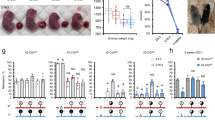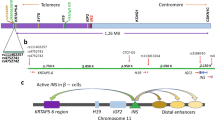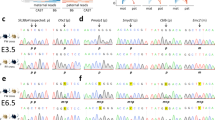Abstract
In mouse, four genes have been found to undergo genomic imprinting resulting in differential expression of maternally and paternally inherited alleles. To determine whether the cognate genes are also subject to imprinting in humans, we have studied allele–specific expression patterns of insulin–like growth factor 2, IGF2–receptor and H19 in human fetal and adult tissues. In keeping with previous findings in mice, our results indicate that in human fetal tissues the paternal H19 allele is inactive. IGF2 is monoallelically expressed in various tissues but surprisingly not in adult human liver. The human IGF2R gene, another classic example of imprinting in mice, was found to be expressed from both alleles. We provide the first direct evidence for differential imprinting in the human and murine genome.
This is a preview of subscription content, access via your institution
Access options
Subscribe to this journal
Receive 12 print issues and online access
$209.00 per year
only $17.42 per issue
Buy this article
- Purchase on Springer Link
- Instant access to full article PDF
Prices may be subject to local taxes which are calculated during checkout
Similar content being viewed by others
References
Cattanach, B.M. Chromosome imprinting and its significance for mammalian development. Genome Analysis 2, 41–71 (1991).
Hadchouel, M., Farza, H., Simon, D., Tiollais, P. & Pourcel, C. Maternal inhibition of hepatitis B surface antigen gene expression in transgenic mice correlates with de novo methylation. Nature 329, 454–456 (1987).
Reik, W., Collick, A., Norris, M.L., Barton, S.C. & Surani, M.A. Genomic imprinting determines methylation of parental alleles in transgenic mice. Nature 328, 248–254 (1987).
Reik, W., Howlett, S.K. & Surani, M.A. Imprinting by DNA methylation: From transgenes to endogenous gene sequences. Development (Suppl.) 99–106 (1990).
Sapienza, C., Peterson, A.C., Rossant, J. & Baling, R. Degree of methylation of transgenes is dependent on gamete of origin. Nature 328, 251–254 (1987).
Swain, J.L., Stewart, T.A. & Leder, P. Parental legacy determines methylation and expression of an autosomal transgene: A molecular mechanism for parental imprinting. Cell 50, 719–727 (1987).
Sasaki, H. et al. Inherited type of allelic methylation variations in a mouse chromosome region where an integrated transgene shows methylation imprinting. Development 111, 573–581 (1991).
DeChiara, T.M., Robertson, E.J. & Efstratiadis, A. Parental imprinting of the mouse insulin-like growth factor II gene. Cell 64, 849–859 (1991).
Barlow, D.P., Stöger, R., Herrmann, B.G., Saito, K. & Schweifer, N. The mouse insulin-like growth factor type-2 receptor is imprinted and closely linked to the Tme locus. Nature 349, 84–87 (1991).
Bartolomei, M.S., Zemel, S. & Tilghman, S.M. Parental imprinting of the mouse H19 gene. Nature 351, 153–155 (1991).
Leff, S.E. et al. Maternal imprinting of the mouse Snrpn gene and conserved linkage homology with the human Prader-Willi syndrome region. Nature Genet. 2, 259–264 (1992).
Özçelik, T. et al. Small nuclear ribonucleoprotein polypeptide N (SNRPN), an expressed gene in the Prader-Willi syndrome critical region. Nature Genet. 2, 265–269 (1992).
Zhang, Y. & Tycko, B. Monoalieiic expression of the human H19 gene. Nature Genet. 1, 40–44 (1992).
Rainier, S. et al. Relaxation of imprinted genes in human cancer. Nature 362, 747–749 (1993).
Ohlsson, R. et al. IGF2 is parentally imprinted during embryogenesis and in the Beckwith-Wiedemann syndrome. Nature Genet. 4, 94–97 (1993).
Giannoukakis, N., Deal, C., Paquette, J., Goodyer, C.G. & Polychronakos, C. Parental genomic imprinting of the human IGF2 gene. Nature Genet. 4, 98–101 (1993).
Ogawa, O. et al. Relaxation of insulin-like growth factor II gene imprinting implicated in Wilms'tumour. Nature 362, 749–751 (1993).
Tadokoro, K., Fujii, H., Inoue, T. & Yamada, M. Polymerase chain reaction (PCR) for detection of ApaI polymorphism at the insulin like growth factor II gene (IGF2). Nucl. Acids Res. 19, 6967 (1991).
Hol, F.A., Geurds, M.P.A., Hamel, B.C.J. & Mariman, E.C.M. Improving the polymorphism content of the 3'UTR of the human IGF2R gene. Molec. Genet. 1, 347 (1992).
Rachmilewitz, J. et al. Parental imprinting of the human H19 gene. FEBS Lett. 309, 25–28 (1992).
Sasaki, H. et al. Parental imprinting: potentially active chromatin of the repressed maternal allele of the mouse insulin-like growth factor II (Igf2) gene. Genes Devel. 6, 1843–1856 (1992).
Soares, M.B. et al. Rat insulin-like growth factor II gene. A single gene with two promoters expressing a multitranscript family. J. molec. Biol. 192, 737–752 (1986).
Tricoli, J.V. et al. Enhanced levels of insulin-like growth factor messenger RNA in human colon carcinomas and liposarcomas. Cancer Res. 46, 6169–6173 (1986).
De Pagter-Holthuizen, P., Jansen, M., Van der Kammen, R.A., Schaik, F.M.A. & Sussenbach, J.S. Differential expression of the human insulin-like growth factor II gene. Characterization of the IGF-II mRNAs and an mRNA encoding a putative IGF-II-associated protein. Biochim Biophys. Acta 950, 282–295 (1988).
Holthuizen, P., Van der Lee, F.M., Ikejiri, K., Yamamoto, M. & Sussenbach, J.S. Identification and initial characterization of a fourth leader exon and promoter of the human IGF-II gene. Biochim. Biophys. Acta 1087, 341–343 (1990).
Raizis, A.M., Eccles, M.R. & Reeve, A.E. Structural analysis of the human insulin-like growth factor-ll P3 promoter. Biochem. J. 289, 133–139 (1993).
Hall, J.G. Genomic imprinting: Review and relevance to human diseases. Am. J. hum. Genet. 46, 857–873 (1990).
Forejt, J. & Gregorová, S. Genetic analysis of genomic imprinting: an imprintor-1 gene controls inactivation of the paternal copy of the mouse Tme locus. Cell 70, 443–450 (1992).
Salido, E.C., Passage, M.B., Yen, P.H., Shapiro, L.J. & Mohandas, T.K. An evaluation of the inactive mouse X chromosome in somatic cell hybrids. Somat. Cell. molec. Genet. 19, 65–71 (1993).
Stöger, R. et al. Maternal-specific methylation of the imprinted mouse Igf2r locus identifies the expressed locus as carrying the imprinting signal. Cell 73, 61–71 (1993).
Heutink, P. et al. A gene subject to genomic imprinting and responsible for hereditary paragangliomas maps to chromosome 11q23–qter. Hum. molec. Genet. 1, 7–10 (1992).
Mariman, E.C.M. et al. Analysis of a second family with hereditary non-chromaffin paragangliomas locates the underlying gene at the proximal region of chromosome 11q. Hum. Genet. 91, 357–361 (1993).
Motokura, T. et al. A novel cyclin encoded by a bcl1-linked candidate oncogene. Nature 350, 512–515 (1991).
Pericak-Vance, M.A. et al. Tight linkage of apolipoprotein C2 to myotonic dystrophy on chromosome 19. Neurology 36, 1418–1423 (1986).
Haas, O.A., Argyriou-Tirita, A. & Lion, T. Parental origin of chromosomes involved in the translocation t(9;22). Nature 359, 414–416 (1992).
Van Der Mey, A.G.L., Maaswinkel-Mooy, P.D., Cornelisse, C.J., Schmidt, P.H. & van de Kami, J.J.P. Genomic imprinting in hereditary glomus tumours: Evidence for new genetic theory. Lancet 1291–1294 (1989).
Maniatis, T., Fritsch, E.F. & Sambrook, J. Molecular cloning: A laboratory manual (Cold Spring Harbor, New York, 1982).
Ponce, M.R. & Micol, J.L. PCR amplification of long DNA fragments. Nucl. Acids Res. 20, 623 (1992).
Author information
Authors and Affiliations
Rights and permissions
About this article
Cite this article
Kalscheuer, V., Mariman, E., Schepens, M. et al. The insulin–like growth factor type–2 receptor gene is imprinted in the mouse but not in humans. Nat Genet 5, 74–78 (1993). https://doi.org/10.1038/ng0993-74
Received:
Accepted:
Issue Date:
DOI: https://doi.org/10.1038/ng0993-74
This article is cited by
-
Lower expression of the equine maternally imprinted gene IGF2R is related to the slow proliferation of hinny embryonic fibroblast in vitro
Molecular Biology Reports (2023)
-
Conflict and the evolution of viviparity in vertebrates
Behavioral Ecology and Sociobiology (2022)
-
Identification of a novel antisense noncoding RNA, ALID, transcribed from the putative imprinting control region of marsupial IGF2R
Epigenetics & Chromatin (2018)
-
Insulin-Like Growth Factor-II/Cation-Independent Mannose 6-Phosphate Receptor in Neurodegenerative Diseases
Molecular Neurobiology (2017)
-
Loss of RNA expression and allele-specific expression associated with congenital heart disease
Nature Communications (2016)



